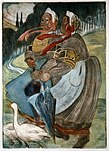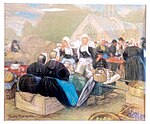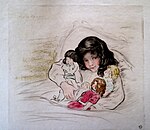Malo-Renault
Malo-Renault (1870-1938) trouve son inspiration de sa terre natale, Saint-Malo et la Bretagne : les paysages et les Bretons sont les premiers sujets de ses pastels et ses estampes en couleur. Une deuxième partie de son œuvre traduit la grâce féminine, la mutinerie et la naïveté des enfants. Il est influencé par l’œuvre d'Henri de Toulouse-Lautrec et l’art japonais qui se traduisent par la sobriété. La richesse des tons et la composition décorative est celle d'un coloriste.
-
La famille de Bigoudens tirant un cochon, color etching
-
Les deux pommes, color drypoint
-
La cour de ferme, 1902, color drypoint
-
Le coups de vent, color etching - aquatint
-
Marché Breton, pastel
-
La marchande de Prunes, pastel
-
Mère et Fille, color drypoint
-
Quelqes unes, 15 color drypoint (1904-1906 & 1909)
-
Cinq heure rue de la Paix, 1912, color drypoint
-
L'oreiller aux poupées, 1913, color drypoint
-
La poupée Soldat, 1915, color print
-
Les Cents Bibliophiles, menu 1922, color woocut
|
This is a faithful photographic reproduction of a two-dimensional, public domain work of art. The work of art itself is in the public domain for the following reason:
The official position taken by the Wikimedia Foundation is that "faithful reproductions of two-dimensional public domain works of art are public domain".
This photographic reproduction is therefore also considered to be in the public domain in the United States. In other jurisdictions, re-use of this content may be restricted; see Reuse of PD-Art photographs for details. | ||||











